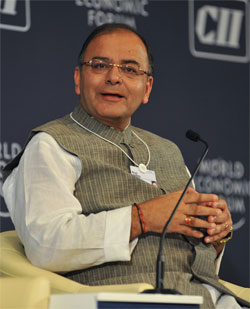Important Points of Economic Survey, 2017-18
Highlights of Economic Survey, 2017-18
The Department of Economic Affairs, Finance Ministry of India presents
the Economic Survey in the parliament every year, just before the Union
Budget. It is prepared under the guidance of the office of Chief Economic
Adviser, Finance Ministry. It is the Ministry's view on the annual economic
development of the country. The Economic Survey reviews the developments in
the Indian Economy over the previous 12 months, summarizes the performance
on major development programs, and highlights the policy initiatives of the
government and the prospects of the Economy in the short to medium term.
This document is presented to both the Houses of Parliament during the
Budget Session.
 'Economic
Survey - 2017-18' is estimated that the growth rate of real gross domestic
product (GDP) will remain 6.75 percent in 2017-18. GDP is estimated to be 7 to
7.5 percent in the coming fiscal year 2018-19. As per the first Advance
Estimates (1st AE), released by the Central Statistics Office (CSO), growth rate
of Gross Value of Added (GVA) at constant base prices was 6.1% in 2017-18,
compared to 6.6% cent in 2016-17. Similarly, 'Agricultural & allied', and
'Industry' sector, are expected to grow 2.1 percent and 4.4 percent.
'Economic
Survey - 2017-18' is estimated that the growth rate of real gross domestic
product (GDP) will remain 6.75 percent in 2017-18. GDP is estimated to be 7 to
7.5 percent in the coming fiscal year 2018-19. As per the first Advance
Estimates (1st AE), released by the Central Statistics Office (CSO), growth rate
of Gross Value of Added (GVA) at constant base prices was 6.1% in 2017-18,
compared to 6.6% cent in 2016-17. Similarly, 'Agricultural & allied', and
'Industry' sector, are expected to grow 2.1 percent and 4.4 percent.
In 2017-18, service sector is expected to grow at 8.3 percent, as compared to 7.7 percent in 2016-17. During the year 2017-18, the average inflation rate was the lowest in the last 6 years. Headline inflation as per Consumer Price Index - Combined (CPI-C) declined to 3.3 percent in 2017-18.
India remains the world's largest exporter of commercial services in 2016 (WTO, 2017) with a share of 3.4 percent. This is double the share of India's merchandise exports in the world. India's services exports grew 5.7 percent in 2016-17 from growth (-) 2.4 percent in 2015-16. Services exports recorded a strong growth of 16.2 percent during April-September 2017.India's service sector imports also showed a much higher growth of 17.4 percent in April-September 2017.
The Industrial Production Index (IIP), which is a volume index with base year, has shown an increase of 3.2% in the industrial production during the period April-November in 2017-18. In November 2017, the IIP registered a growth of 8.4 percent to the April-November growth to 3.2 percent over the corresponding period of the previous year. The eight core infrastructure supportive industries, viz. coal, crude oil, natural gas, petroleum refinery products, fertilizers, steel, cement and electricity that have a total weight of about 40 percent in the IIP.
All theses infrastructure achieved a cumulative growth of 3.9 percent during April-November 2017- 18 over the corresponding period of previous year. The production growth of coal, natural gas, refinery products, steel, cement and electricity were positive Steel production has seen a significant increase while crude oil and fertilizer production declined during this period.
Total foreign direct investment inflows increased by 8 percent, i.e., to 60.08 billion dollars during the year 2016-17, compared to 55.56 billion dollars in the previous year. In the year 2017-18 (April-September), the total FDI inflow was $ 33.75 billion. By the end of September, 2017, the total number of mobile connections in India was 1207.04 million, of these 501.99 million in rural areas and 705.05 million in urban areas. 2017-18 (April-September) the number of domestic air travelers in the country was 57.5 million. This recorded an increase of 16 percent. During the year 2017-18 (April-October), FDI equity inflows in service sector increased by 15.0 percent.
In the first eight months of the GST of July 1, 2017, the number of indirect tax payers increased by 50 percent. The increase in direct tax collection of center has been consistent with the previous year and is expected to meet its target of 13.7 percent, while the indirect taxes increased by 18.3 percent in April-November, 2017.India's share of 70 percent of Maharashtra, Gujarat, Karnataka, Tamil Nadu and Telangana.
India's internal business share in the field of goods and services is 60 percent of GDP.Total food grain production was 275.7 million tones (fourth advance estimates) during the year 2016-17. According to the budget estimate 2017-18 fiscal deficit is 3.2 percent of the gross domestic product. The country's foreign exchange reserves reached $ 409.4 billion by December 2017, while it was $ 370.3 billion in 2016-17. As a proportion of the GDP, the expenditure on social services by the Central and the States was made in 2012-13 through 2014-15 of the range of 6%.
-
Report Error |
Official
Website (Economic Survey)
data-matched-content-ui-type="image_card_stacked"
Useful Tips & Articles
तैयारी कैसे करें? |
EXAM SUBJECTS |
STUDY RESOURCESDownload Free eBooks |


